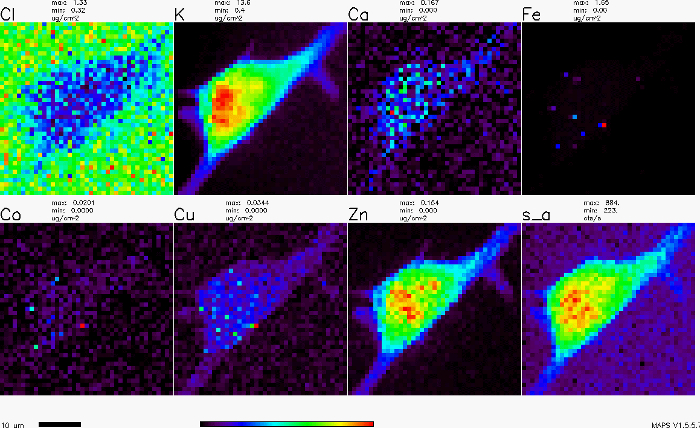X-ray Fluorescence (XRF)
Source: Laboratory of Dr. Lydia Finney — Argonne National Laboratory
X-ray fluorescence is an induced, emitted radiation that can be used to generate spectroscopic information. X-ray fluorescence microscopy is a non-destructive imaging technique that uses the induced fluorescence emission of metals to identify and quantify their spatial distribution.
1. Preparing the Silicon Nitride Windows
- Use reverse tweezers to pick up a window (silicon nitride windows will shatter if dropped).
- Place window onto a glass slide, flat side up.
- Adhere small pieces of Scotch tape to the sides of the window, and use these to adhere the windows to the bottom of the culture dish.
- Sterilize the windows in culture dishes with UV radiation. This can be accomplished with the auto-crosslink setting on a UV-crosslinking cabinet, followed by further UV i
The X-ray fluorescence map of an adherent cell is shown in Figure 1. Each panel shows the distribution of a particular element (e.g., copper, iron, zinc, etc) over the cell. The panel labeled 's_a' shows the absorption of X-rays.
Log in or to access full content. Learn more about your institution’s access to JoVE content here
Figure 1. X-ray fluorescence map of an adherent cell.
X-ray fluorescence imaging can be a useful tool in many fields including geosciences, forensic science, materials science, biology, and even in studying our cultural heritage. In materials science, it can help find defects in chips and catalysts made with metals. In cultural heritage work, it has been used to identify poisonous metals in the hair of famous dead people (e.g., Beethoven), and to identify the source of paints used in art. In biology, it is used to study the natural metals that perform important biochemistry
Перейти к...
Видео из этой коллекции:

Now Playing
X-ray Fluorescence (XRF)
Analytical Chemistry
25.3K Просмотры

Sample Preparation for Analytical Characterization
Analytical Chemistry
84.1K Просмотры

Internal Standards
Analytical Chemistry
204.2K Просмотры

Method of Standard Addition
Analytical Chemistry
319.2K Просмотры

Calibration Curves
Analytical Chemistry
793.3K Просмотры

Ultraviolet-Visible (UV-Vis) Spectroscopy
Analytical Chemistry
620.5K Просмотры

Raman Spectroscopy for Chemical Analysis
Analytical Chemistry
51.0K Просмотры

Gas Chromatography (GC) with Flame-Ionization Detection
Analytical Chemistry
280.8K Просмотры

High-Performance Liquid Chromatography (HPLC)
Analytical Chemistry
382.8K Просмотры

Ion-Exchange Chromatography
Analytical Chemistry
263.6K Просмотры

Capillary Electrophoresis (CE)
Analytical Chemistry
93.2K Просмотры

Introduction to Mass Spectrometry
Analytical Chemistry
111.9K Просмотры

Scanning Electron Microscopy (SEM)
Analytical Chemistry
86.7K Просмотры

Electrochemical Measurements of Supported Catalysts Using a Potentiostat/Galvanostat
Analytical Chemistry
51.3K Просмотры

Cyclic Voltammetry (CV)
Analytical Chemistry
123.9K Просмотры
Авторские права © 2025 MyJoVE Corporation. Все права защищены